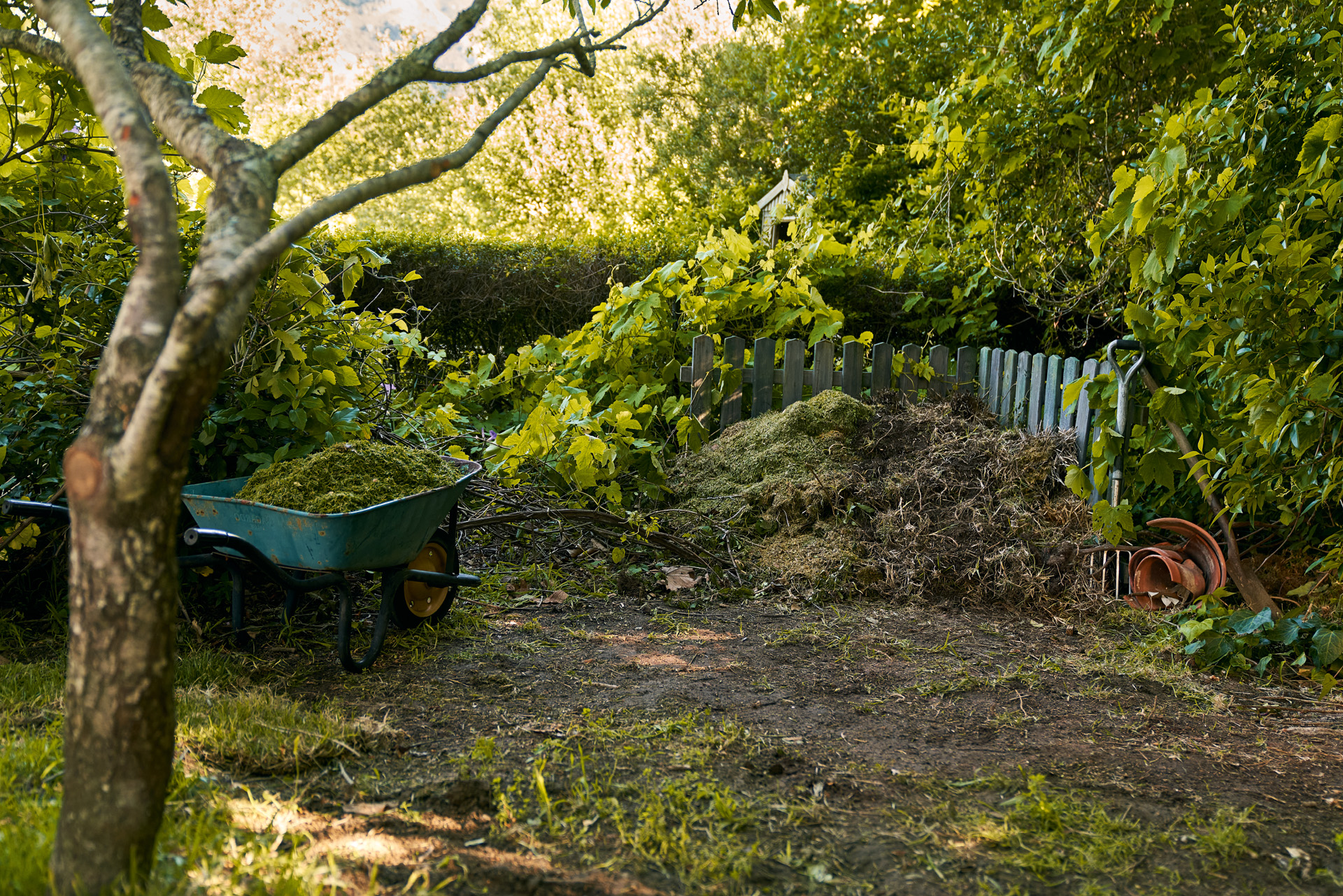How to identify and treat lawn problems
Problems with your lawn can occur in all kinds of gardens. Our guide can help you identify the issue and treat it effectively.
07.04.2022

Don’t just fret about lawn problems: diagnose the issue and treat it
Discoloured patches, weeds, bald spots: even with the best care, your lawn can still be hit by diseases and other issues. We’ve noted the most common lawn problems, explained what causes them, and put together treatment guidance so you can get back to loving your lawn.
Patchy lawns
Whether your lawn patches are brown, yellow, or pale green, there are various reasons you may be suffering this problem. When summer sun scorches your lawn, or a shortage of nutrients causes the plants to struggle, your lush, green lawn can quickly become an untidy patchwork. Dog urine can also cause brown patches, which appear as circles in the lawn and are easily identifiable. We have some tips for dealing with and treating lawn diseases that cause patchiness.

Lawn problems: brown patches on the lawn
| Symptom | Brown to light-brown patches |
|---|---|
| Cause: Dehydration | If the lawn becomes brown to light-brown, or extensive bare patches form, it may be suffering from dehydration. |
| Action | This problem can be easily remedied by regular watering. Consider the mowing height too; if in doubt, keep the grass a little longer. |
| Cause: Overuse | It’s not just diseases: overuse can damage your lawn too. Poor quality seed or a delicate grass variety in a garden that is heavily used by children, for example, will quickly lead to dying grass and brown or bare patches. |
| Action | Sow the right type of lawn. |
| Cause: Drying out | Hot weather causes the lawn to wilt and dry out. |
| Action | During prolonged heatwaves, it is vital to water the lawn regularly. Keeping it longer also offers improved protection against drying out. |
| Cause: Waterlogging | If the lawn becomes matted with dead plant material or moss, it may become waterlogged, suffocating the grass. |
| Action | Regular scarifying and top dressing is one solution. Find out more about scarifying here. |

Lawn problems: yellow and pale-green discolouration
| Symptom | Yellow tips and pale green blades |
|---|---|
| Cause | This kind of discolouration is an indicator of inadequate fertilising, poor soil structure with low humus content or the wrong pH value. These deficiencies make plants vulnerable to diseases. |
| Action | Here’s the good news: iron and nitrogen deficiencies can be quickly remedied and, with additional watering, can supply the lawn with the nutrients it needs, so unsightly yellow patches disappear within days. You can prevent new discolouration through regular fertilising and watering and by making sure that the grass is cut to a reasonable height (not too short). |

Lawn problems: overfertilising
Like all plants, a lawn can be overfertilised. Supplying an excess of certain nutrients, especially mineral fertilisers, may lead to discolouration and dead grass. The lawn will initially turn dark green or even a blueish colour. This kind of overfertilising can add too much salt to the soil, which in turn “burns” the blades.
Lawn problems: discolouration after winter
Frost and cold may damage the lawn, causing diseases, patchiness, and even mould. To prevent this, we recommend a little winter prep for your lawn. Fertilise it in August or September to make the grass strong for the cold season. You can also apply lime in autumn if a pH test suggests that it is necessary. Then cut the lawn to a height of 5 cm. These preparations put the grass in better shape for the winter, prevent extensive dieback, and in the end, give you a lusher, greener lawn. Any discolouration tends to grow out quickly on a well-aerated lawn fed with organic fertiliser.
Lawn diseases: prevent and identify fungal lawn diseases
Along with unsightly patches and discolouration, fungal diseases can also infest the lawn and spoil its appearance. Various influences that can cause these diseases include:
- Extremely dense growth (thick turf)
- Continuous heavy use (e.g. on sports fields, but also frequent walking on the grass in frosty conditions)
- High humidity or waterlogging
- Mulching too thickly
- Wrong soil pH
- Matted lawn
- Cutting grass too short
- Lawn in shaded area, such as within high walls or woodland
- Leaves left lying around or grass too long in winter
- Overwatering or overfertilising
Preventing lawn fungus starts with selecting the right seed. High-quality seed tends to produce less fungus and is generally more resistant to lawn diseases. As so often with lawns, the combination of lawn use and lawn type is also important, and the two must be matched.
Unfortunately, fungus can never be completely ruled out, even on the best-kept lawn. However, most fungal diseases are harmless and simply detract from the lawn’s appearance.
Lawn diseases: snow mould

| Symptom | Grey-brown patches on the lawn that may extend to 30 cm in diameter and have a grey-white, cottony structure called mycelium around their edges. |
|---|---|
| Cause | As the name suggests, snow mould forms on lawns in damp, cold weather. The spores are always present, but infection occurs at 0-10°C. |
| Action | Snow mould usually dies off by itself with warmer summer temperatures. If you want to tackle the worst patches before then, you can scarify the affected area. Sowing new seed in spring can also help. Covering the affected area with a 2 cm layer of sand can prevent reinfection while loosening the soil and improving drainage to prevent waterlogging. |
Lawn diseases: red thread

| Symptom | The tips of the grass blades are a red-brown colour. |
|---|---|
| Cause | Red thread is an indication of a poorly nourished lawn. It may also suggest excessive matting. The fungus mainly occurs at temperatures of between 15-20°C. High humidity also promotes fungal growth. |
| Action | To treat red thread, we recommend scarifying the affected area. An organic mineral fertiliser with low nitrogen and high potassium content can also help the process. |
Lawn diseases: fairy rings

| Symptom | The evocative name (also known as fairy circles) describes circular patterns of mushrooms on the lawn. |
|---|---|
| Cause |
Mycelium lies below the lawn’s surface: a network of fungi that can spring up overnight. Various fungi (up to 60 types are recognised) may form fairy rings. |
| Action | As with many lawn diseases, treating this requires patience. Lift the affected areas in spring or winter with a fork, and loosen the turf to break up the mycelium. These areas should then be watered heavily and frequently. The area may be left soaking wet for two weeks. |
Lawn diseases: powdery mildew

| SYMPTOM | On a lawn, powdery mildew appears as a fine white layer on the blade’s surface. |
|---|---|
| Cause | Outbreaks tend to be caused by warm, humid weather and keeping grass long. This disease often occurs in shaded areas. |
| Action | We recommend that you sow new grass the following spring. You can also provide more sunlight by thinning out trees and cutting back branches. A mix of shade-tolerant and sport turf grass can be useful in these spots. |
Lawn diseases: dollar spot

| SYMPTOM | Dollar spot frequently appears in summer, and is characterised by brown, coin-sized patches. |
|---|---|
| Cause | The fungus thrives on weakened grass which suffers in the heat of the day, and forms the perfect breeding ground for spores at night due to falling temperatures and humidity. |
| Action | Tend the lawn well, ensure it is properly watered, and fertilise it with the minerals it is lacking. |
Lawn diseases: dieback

| SYMPTOM | Dieback in lawns mainly affects newly sown grass. Young blades droop and develop a light-brown collar. |
|---|---|
| Cause | Causes include low-quality seed, inadequate soil aeration and often, overfertilising. |
| Action | This can be remedied by aerating the soil (scarifying), using better seed, and fertilising according to lawn type. |
Lawn problems: how to get rid of moss in the lawn

| SYMPTOM | Mosses spread between the grass stems and gradually displace them. This causes the lawn to become matted. |
|---|---|
| Cause | If moss is taking over your lawn, there is an imbalance somewhere. Moss growth indicates a lack of nutrients, waterlogging, or inadequate aeration. Your soil may also be at the wrong pH. |
| Action | Moss thrives in lawns that have been cut too short and amid weak plants in general, which is why moss is best cured by adjusting the cutting height and fertilising adequately. Use a scarifier to remove the moss from the lawn, then work on restoring balance. |
Summary: lawn problems and diseases
- Lawn problems and diseases manifest in different ways that are easy to spot.
- With the right care, your lawn can stay healthy – but there is always potential for diseases.
- Lawn discolouration is often a sign that the grass lacks nutrients and is also a symptom of common mistakes such as mowing too short.
- There are many different types of fungus, but their impact on your lawn is mostly cosmetic.
- Normally, scarifying, better watering, and proper fertilising can help prevent fungus infestations.
- Moss can be treated by regular fertilising and scarifying.


